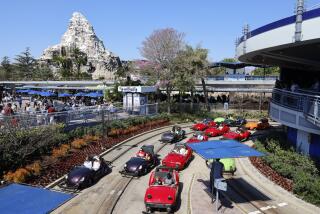Ford is thinking big with its little Fiesta
Whether it’s date night at the El Pollo Loco or trading clothes at a swap, it’s never been so hip to live econo. Now Ford is hoping to capitalize on the trend with a new take on an old car designed for the fashionably frugal — and young.
It’s called the Fiesta. And while Ford’s latest isn’t quite a party on four wheels, the frisky, affordable Fiesta seems to have hit the sweet spot of fuel economy and up-to-the-minute technology, wrapping it all in a wash of electrifying colors that may zap the math that small + car = boring.
When it wheels onto U.S. soil this summer, the Fiesta will be celebrated for many things, most notably its value. The car, which is available in four- and five-door versions, starts at the credit-friendly price of $13,995, boasts 40 miles per gallon highway and is tricked out with technologies, both inside and out, that will have Ford’s higher-end products asking, “What about me?”
Patience, grasshopper.
Ford is devoting more of its energies to small cars these days, having seen the segment grow from 14% of the industry in 2004 to 22% last year. Though $5-per-gallon gas gave small cars a kick a couple years back, continued consumer demand is likely, independent of gas prices, as drivers willingly downsize from their Big Gulps. By 2013, Ford will have downshifted its production of large SUVS and trucks from 50% of its product mix to 39%, in favor of more economical models, such as the Fiesta, now the bestselling small car in Europe.
It used to be that the mere mention of a small car was enough to prompt a yawn. But with its Fiesta, Ford hopes to open people’s mouths for a different reason: to say “Wow.” In its reach for the youth market, the company is walking a tightrope, balancing fuel efficiency with fun, safety with style, cost with quality and plenty of onboard tech — a must-have for a demographic whose thumbs are always moving.
I spent a day inside the Fiesta, which unlocks with an electronic fob and starts with the push of a button, rather than a key. After I’d gotten past the sunglass-inducing shade of lime-squeeze metallic I’d been given, I found the interior more spacious — and far more plush — than I was anticipating. I’m all leg, no torso. And there was more than enough room to stretch out. The back seat, though small, could comfortably accommodate two — as long as they weren’t gorillas.
The Fiesta comes with optional leather — and heated — seats, as well as a moon roof through which drivers can gaze and dream about their futures, even if that’s as immediate as where to grab a beer. For that, drivers are better off looking at their dashboards, where a small black-and-red screen will heed driver’s requests and commands. Rather than build an expensive full-screen nav system or Internet infrastructure into the car, the Ford communications and entertainment system known as Sync leverages the one piece of equipment few people leave home without — a cellphone.
Syncing up a BlackBerry or other smart phone wirelessly via Bluetooth is accomplished with the touch of a few buttons on the device and the screen. Drivers can then make hands-free calls, get turn-by-turn directions based on a GPS receiver built into the car and even check their text messages with the help of voice software that reads the texts out loud. Dubbed Samantha by Ford’s in-house tech gurus, the disembodied feminine voice functions a little like HAL from the film “2001: A Space Odyssey,” only less creepy.
Sync debuted 2-1/2 years ago in the Focus. With the Fiesta, Ford is adding a new feature. Influenced, it seems, by the Apple statistic that there have been more than 4 billion downloads of apps in the last two years, Ford’s new AppLink system allows drivers hands-free access to three apps: Pandora Internet radio; Stitcher, a program that stitches together radio news feeds; and Open Beak, to access Twitter feeds, which Samantha reads aloud in a slightly stilted robotic voice. Ford will add other apps later this year.
AppLink is operated using voice commands — a system that will get instant parental approval as a safety feature (even if future apps may not).
While safety is probably not on the list of must-haves for immortal 20-somethings, it probably is for mom and dad. The Fiesta has seven air bags, including a driver’s-side knee air bag to cushion knee caps kneecaps and femurs should drivers inadvertently steer themselves into a ditch. The car also incorporates not-quite-kryptonite-strength boron in the doors’ support beams.
But enough with the siesta talk. This car is called the Fiesta for a reason, and not just because it’s built in Mexico. It’s quite fun to drive for a car of its size. Though the 1.6-liter inline four doesn’t have a huge amount of pep, it’s light on its feet and adequately responsive in all the areas where it counts: accelerating, braking and steering.
Fiesta marks the debut of Ford’s first fully electromechanical dual dry clutch — the only one in a car on the U.S. market. The dual-clutch system was developed to improve the efficiency of the new “power shift” automatic transmission, which uses a computer to control shift timing and eliminates the torque converter, and the power loss that results from it, to increase the car’s fuel economy.
The Fiesta is available in five-speed manual and six-speed automatic transmission versions. The automatic is outfitted with something called grade assist, which keeps the engine revving higher when it’s climbing hills and downshifts a gear on descent in an effort to keep the driving sporty while also saving gas.
I’m a motorcyclist, but I found the automatic more fun to drive than the manual as I wheeled it through San Francisco’s canyon country. That’s good news for the young ‘uns who are likely to embrace this car and probably didn’t learn to drive, as I did, bucking a Plymouth Duster with a four-speed stick.
A sports car it is not, but at least Ford is thinking big while it re-engineers the idea of small.






